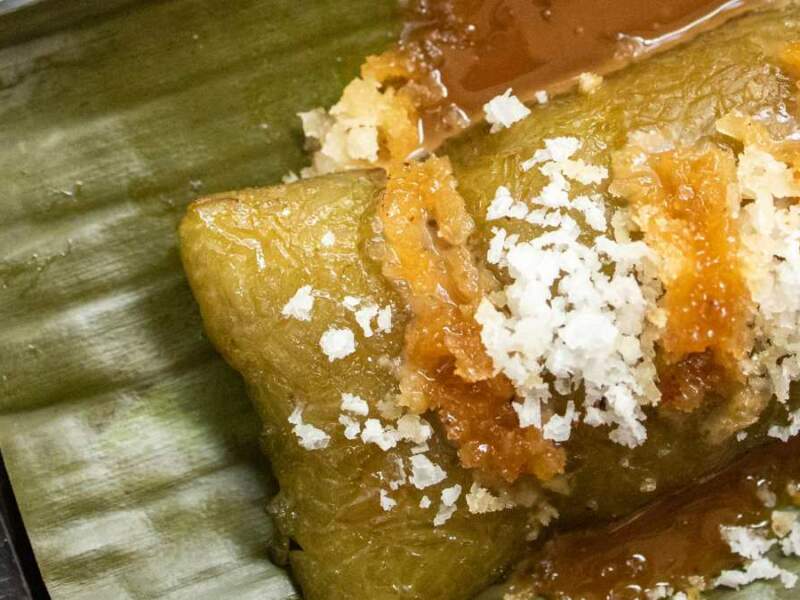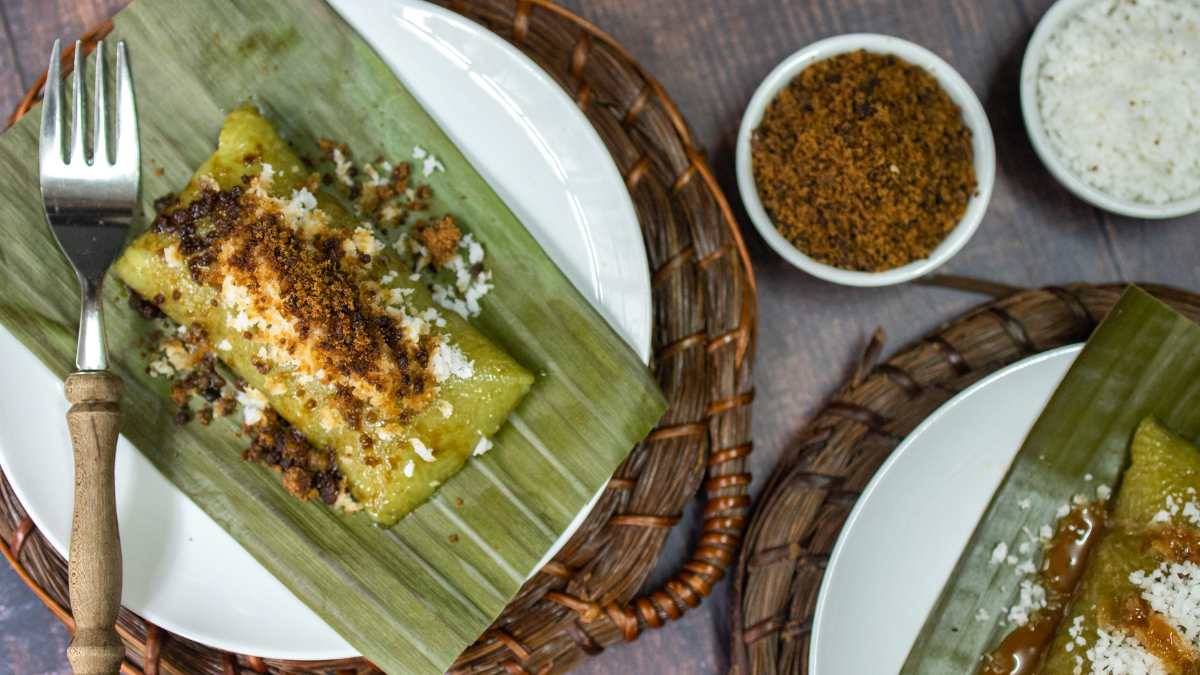The rainy nights and cool breeze of the approaching Christmas season always take me back to special memories of suman-making as a little girl. Growing up in Marinduque, we have strong traditions surrounding these sticky rice treats during the holidays.
Some of my fondest memories were staying up late with all the elders around an open fire, cooking batches upon batches of suman non-stop through the night. The women would work together seamlessly wrapping each parcel just so in young coconut leaves, while the menfolk’s task was skillfully removing the spines to avoid punctures.
It was always a busy, lively scene filled with storytelling and laughter as everyone helped ensure that the family had enough suman to share amongst ourselves as well as bring to neighbors, relatives, and the ones who come knocking. I remember fighting sleep just to take in the warmth and togetherness on those cool evenings.
By morning, everything would be delivered fresh and hot for breakfast. The intoxicating aromas of suman mingling with firewood smoke took me right back each Christmas thereafter.
Nowadays, with the rainy season in full swing, nostalgia is on the loose and I’ve been on the hunt for these sweet rice treats to enjoy. The good thing is that you don’t have to wait overnight to cook these delightful morsels. My recent experiment making suman in the rice cooker was such a success, I decided to try adapting the recipe for my instant pot too. While the cooking methods differ slightly, both appliances produce tender, delicious results with minimum effort.
For my non-Filipino readers, suman is a Filipino specialty of sticky rice steamed inside coconut or banana leaves. It’s often served with a sweet coconut syrup for dipping.
How to cook Suman sa Lihiya
This recipe calls for soaking glutinous rice for an hour before cooking it with a pinch of salt and lye water in the instant pot using the “rice” setting. This infuses the rice with a subtle tanginess.
Once the pot switches to warm, the rice is cooled slightly then packed into banana leaves which was run over fire to make it more pliable and so it doesn’t rip. I fold each leaf parcel tightly shut with butcher’s twine before stacking them on the trivet. Pouring a half cup of water into the pot, I secure the lid and press “manual” to high pressure for 12 minutes.
When natural pressure release finishes, the foil parcels can be unwrapped to reveal plump, tender suman. For the coconut syrup, I heat coconut milk, brown sugar, salt and butter together until thickened. Both components come together beautifully – the rich sauce complements the delicate rice cakes perfectly.
Sourcing Ingredients
Being from the province, one challenge of living in the city is access to ingredients that we easily sourced back home. Things like young coconut leaves and banana leaves are near impossible to find in most urban grocery stores. I’ve had to get creative and join online community groups where fellow kababayans trade produce and goods. Through connections there, I’ve been able to score a few batches of leaves that get at home when I need them.. For glutinous rice, they’re mostly available in the market and if you’re outside the Philippines, I see that specialty Asian supermarket imports direct from the Philippines. Amazon is also a great help for weird ingredients such as the lye. It’s more expensive than what we’d pay at local markets back in Marinduque or even just get in the backyard like the banana leaves, but worth it to maintain my culinary traditions. I belive that adaptation is key but community helps keep those provincial roots alive.
So whether you prefer rice cooker convenience or instant pot efficiency, I’m confident you’ll love this simple suman recipe. Feel free to play with add-ins like jackfruit or ube too. As always, let me know if you give it a try!
PS,
I forgot about this but if you’re having trouble getting lye, you can totally skip that and make just the traditional suman. Regular suman is the basic steamed sticky rice wrapped in banana leaves that I grew up eating all over Marinduque. It tends to be on the softer, less chewy side.
Suman sa lihiya on the other hand, incorporates a subtle souring agent using lye water (lihiya in Tagalog). Just a tiny amount is added to the rice before steaming, giving it a lovely subtle tang. This version originates from areas like Pampanga and Bulacan if I recall correctly.
The lihiya creates a more robust texture in the suman – still soft and melt-in-your-mouth, but with a pleasant firmness and bouncy bite versus being completely soft. I personally prefer that interesting texture profile. It also deepens the natural yellow color of the rice nicely.
Suman sa Lihiya in the Rice Cooker or Instant Pot

Ingredients
Suman
- 2 1/2 cup glutinous rice
- 3 cups of water
- 1 tsp of salt
- 2 tsp of lye
- banana leaves (wilted)
- oil for brushing banana leaves
- string
- grated coconut
- sugar
- butter
For Coconut Syrup
- 2 cups coconut milk
- 1 1/4 cup brown sugar
- 1 tsp salt
- 2 tbsp butter
Tools Needed:
- Instant Pot or pressure cooker
- Saucepan
Instructions
- Soak the glutinous rice in water for 1 hour. Drain and set aside.
- In instant pot, put together rice, water, lye, and salt. Stir to combine.
- Secure the lid and cook the rice using the Instant Pot's "Rice" function on high pressure for 10-12 minutes. Let pressure release naturally.
- Once cooled slightly, take desired portions of rice and form into logs.
- Lay out banana leaves and place rice log in the center. Wrap securely with the leaf and tie with string.
- Place the wrapped suman in the pressure cooker steamer basket. Secure lid and pressure cook on high pressure for 12 minutes.
- In the meantime, make the coconut syrup. In a saucepan, combine coconut milk, brown sugar, salt and butter. Cook over medium heat, stirring frequently, until thickened to a syrup-like consistency.
- Allow pressure in instant pot to release naturally for 15 minutes, then quick release remaining steam.
- Serve warm suman drizzled with coconut syrup. Enjoy!
How to wilt banana leaves
- To wilt the banana leaves, hold them one at a time directly over an open gas stove flame or coal fire. Move them back and forth for a few seconds until they are flexibile but not burnt.
Notes
Tips:
Soaking the rice before cooking helps it get soft and sticky.
Wilting the banana leaves makes them more pliable for wrapping.
Tie securely with string so the filling doesn't leak during pressure cooking.
Variations:
Different sweet fillings like jackfruit, banana or sweet potato can be used.
Toppings like grated coconut, latik or ampao can be added.
In some areas, suman is steamed instead of pressure cooked.
Pairings:
Serve warm suman with coffee or chocolate drink sikwate for dessert.
Leftovers:
Refrigerate wrapped suman up to 3 days.
To freeze, wrap individually then pack in airtight container up to 3 months. Reheat in steamer or microwave.
Hacks:
Make the coconut syrup in batches and freeze for future use.
Nutritional Benefits:
Glutinous rice is a good source of fiber, magnesium and manganese which are important for energy metabolism.
Coconut milk adds healthy fats while the brown sugar provides natural sugars for energy.


